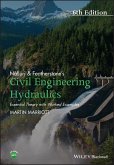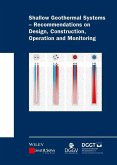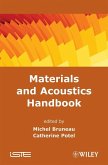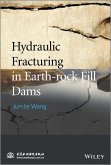207,99 €
207,99 €
inkl. MwSt.
Sofort per Download lieferbar

0 °P sammeln
207,99 €
Als Download kaufen

207,99 €
inkl. MwSt.
Sofort per Download lieferbar

0 °P sammeln
Jetzt verschenken
Alle Infos zum eBook verschenken
207,99 €
inkl. MwSt.
Sofort per Download lieferbar
Alle Infos zum eBook verschenken

0 °P sammeln
- Format: ePub
- Merkliste
- Auf die Merkliste
- Bewerten Bewerten
- Teilen
- Produkt teilen
- Produkterinnerung
- Produkterinnerung

Bitte loggen Sie sich zunächst in Ihr Kundenkonto ein oder registrieren Sie sich bei
bücher.de, um das eBook-Abo tolino select nutzen zu können.
Hier können Sie sich einloggen
Hier können Sie sich einloggen
Sie sind bereits eingeloggt. Klicken Sie auf 2. tolino select Abo, um fortzufahren.

Bitte loggen Sie sich zunächst in Ihr Kundenkonto ein oder registrieren Sie sich bei bücher.de, um das eBook-Abo tolino select nutzen zu können.
Sonar and Underwater Acoustics brings together all the concepts necessary for designers and users of sonar systems. Unlike other books on this subject, which are often too specialized, this book is accessible to a wider audience. The first part focuses on the acoustic environment, antenna structures, and electric acoustic interface. The latter provides knowledge required to design, as well as the development and implementation of chain processes for an active sonar from the conditioning input to output processing. The reader will find a comprehensive range of all problems encountered in…mehr
- Geräte: eReader
- mit Kopierschutz
- eBook Hilfe
- Größe: 12.15MB
Andere Kunden interessierten sich auch für
![Sonar and Underwater Acoustics (eBook, PDF) Sonar and Underwater Acoustics (eBook, PDF)]() Jean-Paul MarageSonar and Underwater Acoustics (eBook, PDF)207,99 €
Jean-Paul MarageSonar and Underwater Acoustics (eBook, PDF)207,99 €![Nalluri And Featherstone's Civil Engineering Hydraulics (eBook, ePUB) Nalluri And Featherstone's Civil Engineering Hydraulics (eBook, ePUB)]() Martin MarriottNalluri And Featherstone's Civil Engineering Hydraulics (eBook, ePUB)43,99 €
Martin MarriottNalluri And Featherstone's Civil Engineering Hydraulics (eBook, ePUB)43,99 €![Shallow Geothermal Systems (eBook, ePUB) Shallow Geothermal Systems (eBook, ePUB)]() Deutsche Gesellschaft Für GeotechnikShallow Geothermal Systems (eBook, ePUB)106,99 €
Deutsche Gesellschaft Für GeotechnikShallow Geothermal Systems (eBook, ePUB)106,99 €![An Introduction to Thermogeology (eBook, ePUB) An Introduction to Thermogeology (eBook, ePUB)]() David BanksAn Introduction to Thermogeology (eBook, ePUB)107,99 €
David BanksAn Introduction to Thermogeology (eBook, ePUB)107,99 €![Materials and Acoustics Handbook (eBook, ePUB) Materials and Acoustics Handbook (eBook, ePUB)]() Materials and Acoustics Handbook (eBook, ePUB)416,99 €
Materials and Acoustics Handbook (eBook, ePUB)416,99 €![Hydraulic Fracturing in Earth-rock Fill Dams (eBook, ePUB) Hydraulic Fracturing in Earth-rock Fill Dams (eBook, ePUB)]() Jun-Jie WangHydraulic Fracturing in Earth-rock Fill Dams (eBook, ePUB)139,99 €
Jun-Jie WangHydraulic Fracturing in Earth-rock Fill Dams (eBook, ePUB)139,99 €![Water Centric Sustainable Communities (eBook, ePUB) Water Centric Sustainable Communities (eBook, ePUB)]() Vladimir NovotnyWater Centric Sustainable Communities (eBook, ePUB)123,99 €
Vladimir NovotnyWater Centric Sustainable Communities (eBook, ePUB)123,99 €-
-
-
Sonar and Underwater Acoustics brings together all the concepts necessary for designers and users of sonar systems. Unlike other books on this subject, which are often too specialized, this book is accessible to a wider audience. The first part focuses on the acoustic environment, antenna structures, and electric acoustic interface. The latter provides knowledge required to design, as well as the development and implementation of chain processes for an active sonar from the conditioning input to output processing. The reader will find a comprehensive range of all problems encountered in underwater acoustics for a sonar application, from physical phenomena governing the environment and the corresponding constraints, through to the technical definition of transducers and antennas, and the types of signal processing involved. In one section, measures in underwater acoustics are also proposed.
Dieser Download kann aus rechtlichen Gründen nur mit Rechnungsadresse in D ausgeliefert werden.
Produktdetails
- Produktdetails
- Verlag: John Wiley & Sons
- Erscheinungstermin: 7. Februar 2013
- Englisch
- ISBN-13: 9781118600658
- Artikelnr.: 37486060
- Verlag: John Wiley & Sons
- Erscheinungstermin: 7. Februar 2013
- Englisch
- ISBN-13: 9781118600658
- Artikelnr.: 37486060
- Herstellerkennzeichnung Die Herstellerinformationen sind derzeit nicht verfügbar.
Jean-Paul Marage is the author of Sonar and Underwater Acoustics, published by Wiley.
Yvon Mori, Consultant, France. Although retired from his main activities as an electronic engineer, he is still Chairman of the SEE French Riviera (Société de l'Electricité, de l'Electronique et des Technologies de l'Information et de la Communication) and the IEEE in France. He is also a COFRAC Auditor for programme 38 and trains engineers in mechanical vibration, shock analysis and electromagnetic compatibility for major companies. Before retirement he was, for 37 years, the manager of the environmental test and evaluation laboratory at Thales Underwater Systems in Sophia Antipolis, France.
Yvon Mori, Consultant, France. Although retired from his main activities as an electronic engineer, he is still Chairman of the SEE French Riviera (Société de l'Electricité, de l'Electronique et des Technologies de l'Information et de la Communication) and the IEEE in France. He is also a COFRAC Auditor for programme 38 and trains engineers in mechanical vibration, shock analysis and electromagnetic compatibility for major companies. Before retirement he was, for 37 years, the manager of the environmental test and evaluation laboratory at Thales Underwater Systems in Sophia Antipolis, France.
Preface ix
PART 1. THE MARINE ENVIRONMENT 1
Part 1. Introduction 3
Chapter 1. Problematics 5
1.1. History 5
1.2. Underwater acoustics 7
1.3. Applications 9
1.4. Comparison with radar 10
1.5. Submarine detection and warfare 11
1.6. Submarine detection 11
1.7. Submarine detection: a veritable challenge 12
1.8. Overcoming the effects of the ocean 13
1.9. Sonar and information processing 16
Chapter 2. Sound Propagation in the Marine Environment 19
2.1. General points 19
2.2. Characteristics of the marine environment 19
2.3. Models used 22
2.4. Propagation phenomena 28
2.5. Application examples 33
Chapter 3. Noises and Reverberation 41
3.1. Classification of ambient noises 41
3.2. Analysis of noise sources 45
3.3. Wenz' model of sea noise 51
3.4. Directivity of sea noise 52
3.5. Reverberation 55
Chapter 4. Radiated and Inherent Noises 65
4.1. Radiated noise 65
Chapter 5. Transmission of the Acoustic Signal: Sonar Equations 79
5.1. Introduction 79
5.2. Detection contrast and detection index 80
5.3. Transmission equation 81
5.4. Equation of passive sonar 88
5.5. Equation of active sonar 89
PART 2. ACOUSTIC-ELECTRIC INTERFACE ANTENNA STRUCTURES 93
Part 2. Introduction 95
Chapter 6. Electric-acoustic and Acoustic-electric Transformations 97
6.1. Transducers and hydrophones 97
Chapter 7. Performance and Structures of Acoustic Antennas 113
7.1. Antennas and radiation 113
7.2. Structures of sources and antennas 189
Chapter 8. Electronic Transducer-hydrophone Adaptation 211
8.1. Hydrophones 211
8.2. Transducers 243
Chapter 9. Electro-mechano-acoustic Analogies 269
9.1. Methods of studying transducers and hydrophones 269
9.2. Mechanic-electric equivalence 270
9.3. Electric-acoustic equivalence 275
9.4. Finite element method (FEM) 320
PART 3. PROCESSING CHAIN OF ACTIVE SONAR 323
Part 3. Introduction 325
Chapter 10. Selection Criteria in Active Processing 327
10.1. Selection criteria related to propagation 327
10.2. Selection criteria relative to noise 331
10.3. Selection criteria related to reverberation 332
10.4. Selection criteria related to emission power 333
10.5. Selection criteria related to the antenna 335
10.6. Selection criteria for the operating frequency 336
10.7. Selection criteria related to operational considerations 337
10.8. Selection criteria related to the nature of targets 337
Chapter 11. Processing Chain in Active Sonar 341
11.1. General points 341
11.2. Emission 341
11.3. Reception 345
Chapter 12. Basic Theoretical Notions in Active Processing 459
12.1. The Doppler effect 459
12.2. The Doppler effect in active sonar conditions 464
12.3. Treatment of the signal 485
12.4. Choice of an emission signal under active sonar conditions 503
Chapter 13. Measurement in Underwater Acoustics 525
13.1. Introduction 525
13.2. Wave train method 531
13.3. Precautions before measuring 539
13.4. Acoustic measurements and calibrations of transducers 542
13.5. Notion of uncertainty estimation and of maximum tolerated difference
551
13.6. Other types of measurements in underwater acoustics 553
APPENDICES 555
Appendix 1. Logarithmic Scales 557
Appendix 2. Equation of Sound in Fluids 563
Appendix 3. Piezoelectricity Fundamentals 571
Appendix 4. Vector Analysis ?Ï?nFundamentals 579
Appendix 5. Reciprocity Theorem 593
Appendix 6. Concrete Example of Uncertainty Estimation Based on the
Reciprocity Calibration Method 601
Bibliography 619
Index 623
PART 1. THE MARINE ENVIRONMENT 1
Part 1. Introduction 3
Chapter 1. Problematics 5
1.1. History 5
1.2. Underwater acoustics 7
1.3. Applications 9
1.4. Comparison with radar 10
1.5. Submarine detection and warfare 11
1.6. Submarine detection 11
1.7. Submarine detection: a veritable challenge 12
1.8. Overcoming the effects of the ocean 13
1.9. Sonar and information processing 16
Chapter 2. Sound Propagation in the Marine Environment 19
2.1. General points 19
2.2. Characteristics of the marine environment 19
2.3. Models used 22
2.4. Propagation phenomena 28
2.5. Application examples 33
Chapter 3. Noises and Reverberation 41
3.1. Classification of ambient noises 41
3.2. Analysis of noise sources 45
3.3. Wenz' model of sea noise 51
3.4. Directivity of sea noise 52
3.5. Reverberation 55
Chapter 4. Radiated and Inherent Noises 65
4.1. Radiated noise 65
Chapter 5. Transmission of the Acoustic Signal: Sonar Equations 79
5.1. Introduction 79
5.2. Detection contrast and detection index 80
5.3. Transmission equation 81
5.4. Equation of passive sonar 88
5.5. Equation of active sonar 89
PART 2. ACOUSTIC-ELECTRIC INTERFACE ANTENNA STRUCTURES 93
Part 2. Introduction 95
Chapter 6. Electric-acoustic and Acoustic-electric Transformations 97
6.1. Transducers and hydrophones 97
Chapter 7. Performance and Structures of Acoustic Antennas 113
7.1. Antennas and radiation 113
7.2. Structures of sources and antennas 189
Chapter 8. Electronic Transducer-hydrophone Adaptation 211
8.1. Hydrophones 211
8.2. Transducers 243
Chapter 9. Electro-mechano-acoustic Analogies 269
9.1. Methods of studying transducers and hydrophones 269
9.2. Mechanic-electric equivalence 270
9.3. Electric-acoustic equivalence 275
9.4. Finite element method (FEM) 320
PART 3. PROCESSING CHAIN OF ACTIVE SONAR 323
Part 3. Introduction 325
Chapter 10. Selection Criteria in Active Processing 327
10.1. Selection criteria related to propagation 327
10.2. Selection criteria relative to noise 331
10.3. Selection criteria related to reverberation 332
10.4. Selection criteria related to emission power 333
10.5. Selection criteria related to the antenna 335
10.6. Selection criteria for the operating frequency 336
10.7. Selection criteria related to operational considerations 337
10.8. Selection criteria related to the nature of targets 337
Chapter 11. Processing Chain in Active Sonar 341
11.1. General points 341
11.2. Emission 341
11.3. Reception 345
Chapter 12. Basic Theoretical Notions in Active Processing 459
12.1. The Doppler effect 459
12.2. The Doppler effect in active sonar conditions 464
12.3. Treatment of the signal 485
12.4. Choice of an emission signal under active sonar conditions 503
Chapter 13. Measurement in Underwater Acoustics 525
13.1. Introduction 525
13.2. Wave train method 531
13.3. Precautions before measuring 539
13.4. Acoustic measurements and calibrations of transducers 542
13.5. Notion of uncertainty estimation and of maximum tolerated difference
551
13.6. Other types of measurements in underwater acoustics 553
APPENDICES 555
Appendix 1. Logarithmic Scales 557
Appendix 2. Equation of Sound in Fluids 563
Appendix 3. Piezoelectricity Fundamentals 571
Appendix 4. Vector Analysis ?Ï?nFundamentals 579
Appendix 5. Reciprocity Theorem 593
Appendix 6. Concrete Example of Uncertainty Estimation Based on the
Reciprocity Calibration Method 601
Bibliography 619
Index 623
Preface ix
PART 1. THE MARINE ENVIRONMENT 1
Part 1. Introduction 3
Chapter 1. Problematics 5
1.1. History 5
1.2. Underwater acoustics 7
1.3. Applications 9
1.4. Comparison with radar 10
1.5. Submarine detection and warfare 11
1.6. Submarine detection 11
1.7. Submarine detection: a veritable challenge 12
1.8. Overcoming the effects of the ocean 13
1.9. Sonar and information processing 16
Chapter 2. Sound Propagation in the Marine Environment 19
2.1. General points 19
2.2. Characteristics of the marine environment 19
2.3. Models used 22
2.4. Propagation phenomena 28
2.5. Application examples 33
Chapter 3. Noises and Reverberation 41
3.1. Classification of ambient noises 41
3.2. Analysis of noise sources 45
3.3. Wenz' model of sea noise 51
3.4. Directivity of sea noise 52
3.5. Reverberation 55
Chapter 4. Radiated and Inherent Noises 65
4.1. Radiated noise 65
Chapter 5. Transmission of the Acoustic Signal: Sonar Equations 79
5.1. Introduction 79
5.2. Detection contrast and detection index 80
5.3. Transmission equation 81
5.4. Equation of passive sonar 88
5.5. Equation of active sonar 89
PART 2. ACOUSTIC-ELECTRIC INTERFACE ANTENNA STRUCTURES 93
Part 2. Introduction 95
Chapter 6. Electric-acoustic and Acoustic-electric Transformations 97
6.1. Transducers and hydrophones 97
Chapter 7. Performance and Structures of Acoustic Antennas 113
7.1. Antennas and radiation 113
7.2. Structures of sources and antennas 189
Chapter 8. Electronic Transducer-hydrophone Adaptation 211
8.1. Hydrophones 211
8.2. Transducers 243
Chapter 9. Electro-mechano-acoustic Analogies 269
9.1. Methods of studying transducers and hydrophones 269
9.2. Mechanic-electric equivalence 270
9.3. Electric-acoustic equivalence 275
9.4. Finite element method (FEM) 320
PART 3. PROCESSING CHAIN OF ACTIVE SONAR 323
Part 3. Introduction 325
Chapter 10. Selection Criteria in Active Processing 327
10.1. Selection criteria related to propagation 327
10.2. Selection criteria relative to noise 331
10.3. Selection criteria related to reverberation 332
10.4. Selection criteria related to emission power 333
10.5. Selection criteria related to the antenna 335
10.6. Selection criteria for the operating frequency 336
10.7. Selection criteria related to operational considerations 337
10.8. Selection criteria related to the nature of targets 337
Chapter 11. Processing Chain in Active Sonar 341
11.1. General points 341
11.2. Emission 341
11.3. Reception 345
Chapter 12. Basic Theoretical Notions in Active Processing 459
12.1. The Doppler effect 459
12.2. The Doppler effect in active sonar conditions 464
12.3. Treatment of the signal 485
12.4. Choice of an emission signal under active sonar conditions 503
Chapter 13. Measurement in Underwater Acoustics 525
13.1. Introduction 525
13.2. Wave train method 531
13.3. Precautions before measuring 539
13.4. Acoustic measurements and calibrations of transducers 542
13.5. Notion of uncertainty estimation and of maximum tolerated difference
551
13.6. Other types of measurements in underwater acoustics 553
APPENDICES 555
Appendix 1. Logarithmic Scales 557
Appendix 2. Equation of Sound in Fluids 563
Appendix 3. Piezoelectricity Fundamentals 571
Appendix 4. Vector Analysis ?Ï?nFundamentals 579
Appendix 5. Reciprocity Theorem 593
Appendix 6. Concrete Example of Uncertainty Estimation Based on the
Reciprocity Calibration Method 601
Bibliography 619
Index 623
PART 1. THE MARINE ENVIRONMENT 1
Part 1. Introduction 3
Chapter 1. Problematics 5
1.1. History 5
1.2. Underwater acoustics 7
1.3. Applications 9
1.4. Comparison with radar 10
1.5. Submarine detection and warfare 11
1.6. Submarine detection 11
1.7. Submarine detection: a veritable challenge 12
1.8. Overcoming the effects of the ocean 13
1.9. Sonar and information processing 16
Chapter 2. Sound Propagation in the Marine Environment 19
2.1. General points 19
2.2. Characteristics of the marine environment 19
2.3. Models used 22
2.4. Propagation phenomena 28
2.5. Application examples 33
Chapter 3. Noises and Reverberation 41
3.1. Classification of ambient noises 41
3.2. Analysis of noise sources 45
3.3. Wenz' model of sea noise 51
3.4. Directivity of sea noise 52
3.5. Reverberation 55
Chapter 4. Radiated and Inherent Noises 65
4.1. Radiated noise 65
Chapter 5. Transmission of the Acoustic Signal: Sonar Equations 79
5.1. Introduction 79
5.2. Detection contrast and detection index 80
5.3. Transmission equation 81
5.4. Equation of passive sonar 88
5.5. Equation of active sonar 89
PART 2. ACOUSTIC-ELECTRIC INTERFACE ANTENNA STRUCTURES 93
Part 2. Introduction 95
Chapter 6. Electric-acoustic and Acoustic-electric Transformations 97
6.1. Transducers and hydrophones 97
Chapter 7. Performance and Structures of Acoustic Antennas 113
7.1. Antennas and radiation 113
7.2. Structures of sources and antennas 189
Chapter 8. Electronic Transducer-hydrophone Adaptation 211
8.1. Hydrophones 211
8.2. Transducers 243
Chapter 9. Electro-mechano-acoustic Analogies 269
9.1. Methods of studying transducers and hydrophones 269
9.2. Mechanic-electric equivalence 270
9.3. Electric-acoustic equivalence 275
9.4. Finite element method (FEM) 320
PART 3. PROCESSING CHAIN OF ACTIVE SONAR 323
Part 3. Introduction 325
Chapter 10. Selection Criteria in Active Processing 327
10.1. Selection criteria related to propagation 327
10.2. Selection criteria relative to noise 331
10.3. Selection criteria related to reverberation 332
10.4. Selection criteria related to emission power 333
10.5. Selection criteria related to the antenna 335
10.6. Selection criteria for the operating frequency 336
10.7. Selection criteria related to operational considerations 337
10.8. Selection criteria related to the nature of targets 337
Chapter 11. Processing Chain in Active Sonar 341
11.1. General points 341
11.2. Emission 341
11.3. Reception 345
Chapter 12. Basic Theoretical Notions in Active Processing 459
12.1. The Doppler effect 459
12.2. The Doppler effect in active sonar conditions 464
12.3. Treatment of the signal 485
12.4. Choice of an emission signal under active sonar conditions 503
Chapter 13. Measurement in Underwater Acoustics 525
13.1. Introduction 525
13.2. Wave train method 531
13.3. Precautions before measuring 539
13.4. Acoustic measurements and calibrations of transducers 542
13.5. Notion of uncertainty estimation and of maximum tolerated difference
551
13.6. Other types of measurements in underwater acoustics 553
APPENDICES 555
Appendix 1. Logarithmic Scales 557
Appendix 2. Equation of Sound in Fluids 563
Appendix 3. Piezoelectricity Fundamentals 571
Appendix 4. Vector Analysis ?Ï?nFundamentals 579
Appendix 5. Reciprocity Theorem 593
Appendix 6. Concrete Example of Uncertainty Estimation Based on the
Reciprocity Calibration Method 601
Bibliography 619
Index 623







